Sony DSC-HX400V settings, tips and tricks
Introduction
This is an advanced manual for the SONY HX400V with tips and tricks. I’ll be going through the entire menu system with you and explain you exactly what is what, giving you tips on how to setup your camera along the way. The Sony H400V has little in common with the older HX300, so you’ll see lots of differences in the menu if you come from that camera. Although the basic features did not change (a 1 2/3 BSI CMOS sensor with 20 million pixels and a 50x zoom ranging from 24-1200 mm), several defects have been corrected like a more powerful new Bionz X processor, slightly redesigned optical formula, Wi-Fi and NFC, a new user interface like the Sony RX100 and an accessory hot shoe.

This new menu system might look confusing at first, but you’ll quickly get the hang of it if you spend some time reading this Sony HX400V guide. The Sony manual does offer insights on this, but to be honest, it does not give you a page by page explanation as I do. So sit back, read carefully and get ready to learn. If there is a feature that you don’t want to tweak or learn, just skip it and move to the next chapter.
Diving into the MENU system
When you switch on your camera, you’ll be asked to enter a date, time and timezone. This setting is necessary, as all images captured will have a timestamp, making it easy to find your favorite pictures in the future.
After this is setup, press the MENU button. You’ll see a range of icons and pages.
We’ll start at page 1 of the camera Icon (camera settings)
(MENU → Camera Settings → page 1)
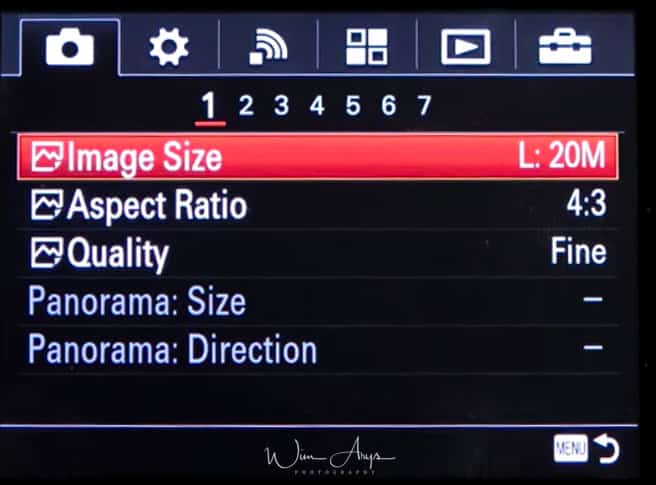
Image size:
The larger the image size, the more detail will be reproduced when the image is saved. The smaller the image size, the more images can be recorded. Much depend upon the intended use for your images, but if you can spare the extra expense of a larger SD card, I would recommend you to set the image size to large.
Knowing the size in pixels at different aspect ratios and quality levels can tell you how large you can print. An A3 print is 3508 pixels x 4961 pixels, so you can comfortably print your images on an A3 paper if you set the Image size to Large. Setting image size to medium would correspond to your image filling on a full-screen 4Kmonitor.
The of your image in pixels when Aspect Ratio is 3:2:
- L: 18M 5184×3456 pixels
- M: 8.9M 3648×2432 pixels
- S:: 4.5M 2592×1728 pixels
The size of your image in pixels when Aspect Ratio is 4:3: (RECOMMENDED):
- L: 20M 5184×3888 pixels
- M: 10M 3648×2736 pixels
- S: 5.0M 2592×1944 pixels
- VGA 640×480 pixels
The size of your image in pixels when Aspect Ratio is 16:9:
- L: 115M 5184×2920 pixels
- M: 7.5M 3648×2056 pixels
- S: 2.1M 1920×1080 pixels
The size of your image in pixels when Aspect Ratio is 1:1:
- L: 15M 3888×3888 pixels
- M: 7.5M 2736×2736 pixels
- S: 3.7M 1920×1920 pixels
Aspect Ratio
You can choose 4:3 (which uses the full sensor surface), 3:2, 1:1 or 16:9 (crop but a more broad view). Unless you are not interested in editing your images later, leave as is at 4:3, you can always crop in a photo editor. Remember that if you decide to use a different aspect ratio, what is cropped out will not be saved.
Quality:
The HX400V is not capable of storing RAW images. RAW basically means that all the information captured by the camera’s sensor is saved unprocessed.
Instead, this camera saves it as a JPEG file. This Jpeg will have gone through all your settings like added sharpness, noise reduction, white balance, etc as well as being compressed to a certain degree.
You have two compression options available: FINE (larger) and STANDARD (smaller, less quality) which takes up less space on your SD card but is less suited for editing afterward.
I always recommend setting Quality to Fine. When you’re investing in a good camera like this, you don’t want to miss out on the fantastic detail in can produce.
Panorama size
(Only available when in panorama shooting mode on the mode dial) Size is selectable between standard and wide. Wide means your picture will cover a larger area. Set it to standard, having to scan an even broader area when making panoramas will take some experience with the camera to do efficiently.
Size is selectable between standard and wide. Wide means your picture will cover a larger area. Set it to standard, having to scan an even broader area when making panoramas will take some experience with the camera to do efficiently.
Set it to standard, having to scan an even broader area when making panoramas will take some experience with the camera to do efficiently.
Panorama direction
A panorama picture is a composite of several images stitched together. When in this mode, you’ll see an arrow that guides you in what direction and speed you should pan the camera to take the sequential images that will be stitched together. You can choose the path in this menu (either, up, down, left or right).
You can make panoramas while scanning your camera up-down or left-right.So what is this all about? This might sound confusing at first, but this comes down to how you hold the Sony DSC-HX400V when shooting panoramas: either in portrait or landscape orientation.
(MENU → Camera Settings → page 2)
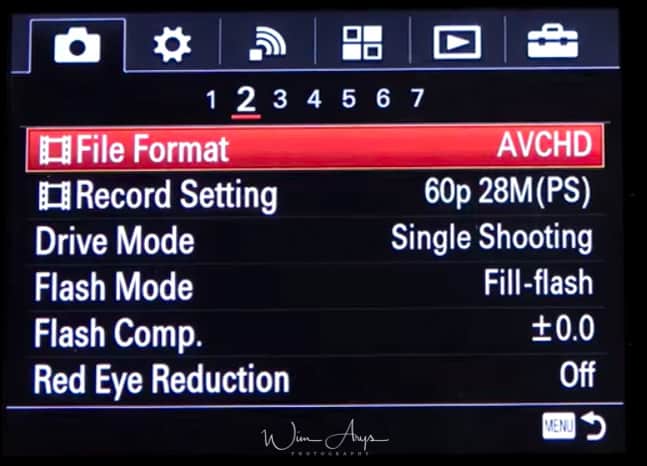
File format (for movies)
Selects the movie file format.
- AVCHD: Records HD movies in AVCHD format. This file format is suitable for high-definition TV. Audio: Dolby Digital
- MP4: Records mp4 (AVC) movies. This format is suitable for playback on smartphones or tablets, web uploads, email attachments, etc. Audio: AAC.
Record setting (also a movie setting)
You can choose the quality of recorded video here. You can change the image size, frame rate, and image quality for movie recording. The higher the bitrate, the higher the image quality. If you’re not familiar with this, leave as is.
When File Format is set to AVCHD:
- 60i/50i: Movies are recorded at approximately 60 fields/sec (for 1080 60i-compatible devices) or 50 fields/sec (for 1080 50i-compatible devices), in interlaced mode, with Dolby Digital audio, in AVCHD format.
- 24p/25p: Movies are recorded at approximately 24 frames/sec (for 1080 60i-compatible devices) or 25 frames/sec (for 1080 50i-compatible devices), in progressive mode, with Dolby Digital audio, in AVCHD format.
- 60p/50p: Movies are recorded at approximately 60 frames/sec (for 1080 60i-compatible devices) or 50 frames/sec (for 1080 50i-compatible devices), in progressive mode, with Dolby Digital audio, in AVCHD format.
When File Format is set to MP4:
- Movies shot are recorded in MPEG-4 format, at approximately 60 frames/sec (for 1080 60icompatible devices), approximately 50 frames/sec (for 1080 50i-compatible devices), approximately 30 frames/sec (for 1080 60i-compatible devices) or approximately 25 frames/sec (for 1080 50i-compatible devices), in progressive mode, with AAC audio, MP4 format.
Menu items details: Settings also depend on your isterion setting PAL/NTSC
When File Format is set to AVCHD:
- 60i/50i 24M(FX): 50i 24M(FX: Records high image quality movies of 1920 × 1080 (60i/50i). Bit-rate: Approx. 24 Mbps (Max.)
- 60i/50i 17M(FH) (default setting)*: 50i 17M(FH) (default setting): Records standard image quality movies of 1920 × 1080 (60i/50i). Bit-rate: Approx. 17 Mbps (Avg.)
- 60p/50p 28M(PS): Records the highest image quality movies of 1920 × 1080 (60p/50p). Bit-rate: Approx. 28 Mbps (Max.)
- 50p 28M(PS): Records the highest image quality movies of 1920 × 1080 (60p/50p). Bit-rate: Approx. 28 Mbps (Max.)
- 24p/25p 24M(FX): 25p 24M(FX)**: Records high image quality movies of 1920 × 1080 (24p/25p). This produces a cinema-like atmosphere. Bit-rate: Approx. 24 Mbps (Max.)
- 24p/25p 17M(FH): 25p 17M(FH)**: Records standard image quality movies of 1920 × 1080 (24p/25p). This produces a cinema-like atmosphere. Bit-rate: Approx. 17 Mbps (Avg.)
When File Format is set to MP4:
- 1440×1080 12M (default setting): Records movies of 1440 × 1080. Bit-rate: Approx. 12 Mbps (Avg.)
- VGA 3M: Records movies of VGA size. Bit-rate: Average 3 Mbps.
General notes:
- 60p/50p movies can be played back only on compatible devices.
- Movies recorded with the [60p 28M(PS)]/[50p 28M(PS)]/[60i 24M(FX)]/[50i 24M(FX)]/ [24p 24M(FX)] /[25p 24M(FX)] setting in [ Record Setting] are converted by PlayMemories Home in order to create an AVCHD recording disc. This conversion can take a long time. Also, you cannot create a disc in the original image quality. If you want to keep the original image quality, store your movies on a Blu-ray Disc.
- To play back60p/50p/24p/25p movies on a TV, the TV must be compatible with those formats. If the TV is not compatible with the 24p/25p format, 24p/25p movies will be output as 60i/50i movies.
Drive Mode
You can set the drive mode, such as continuous or self-timer shooting.
- Single Shooting (default setting): Shoots one still image. Normal shooting mode.
- Cont. Shooting: Shoots images continuously while you press and hold down the shutter button. Hi: takes about ten images per second, Lo about three.
- Self-timer: Shoots an image after 10 or 2 seconds. (selectable in sub menu) You can change the angle of the LCD screen and shoot images while monitoring the image on the screen.
- Self-Portrait: When the HX400V detects the number of faces you have selected, a beep will sound and the shooting starts after two seconds.
- Self-timer(Cont): Shoots a specified number of images continuously after 10, 5 or seconds or 2 seconds (selectable in the sub menu).
- Cont. Bracket: Shoots images while holding the shutter button down, each with different degrees of brightness. (3 images between .3 and 3 EV difference, selectable in the sub menu.) For processing as HDR on your PC.
- WB bracket: Shoots a total of three images, each with a different color tone according to the selected settings for white balance, color temperature, and the color filter. (3 images with either LO small changes or Hi large changes)
Flash Mode
Flash off;
obvious
Autoflash:
The flash works in dark environments or when shooting towards a bright light.
Fill-flash:
The flash works every time you trigger the shutter.
Slow sync:
Tells the camera to use a longer shutter speed along with a flash, and thus is better for night shots. In manual and shutter priority modes, there is no difference in flash power. But when using aperture priority, program, or auto, choosing slow sync tells the camera to use a longer shutter speed than it would ordinarily pick.What the slow sync flash mode actual does is first fire the flash for the subject exposure, then allow for a longer shutter speed that will allow for more ambient light to be captured by the sensor.
Advanced Flash:
The flash automatically operates in dark locations or when there is backlighting. In dark locations, the upper limit value of the ISO sensitivity increases in order to maximize the flash range.
Rear Sync:
Capturing an image involves two shutter actions: one when the capture starts and on when it stops. Rear Sync tells the flash to fire right before the shutter closes. Moving objects will show a streak where they came from and a sharp image where they were at the end of the exposure. This conveys a sense of speed with moving objects. Rear Sync is a creative technique, if you’d like to know more about this type of photography, I’d suggest doing a Google search on ‘Rear Sync Flash Photography.’
Wireless:
When using a wireless flash, the shading effect provides a more 3D appearance to a subject than when using an attached flash. This mode is effective when you attach a remote control-compatible external flash sold separately to the camera, and shoot with a wireless flash, placed away from the product. If you’re looking for a suitable flash, you’ll need one that corresponds to the Sony MIS (multi-interface shoe). If you want to save some money, have a look at brands like Godox or Neewer.
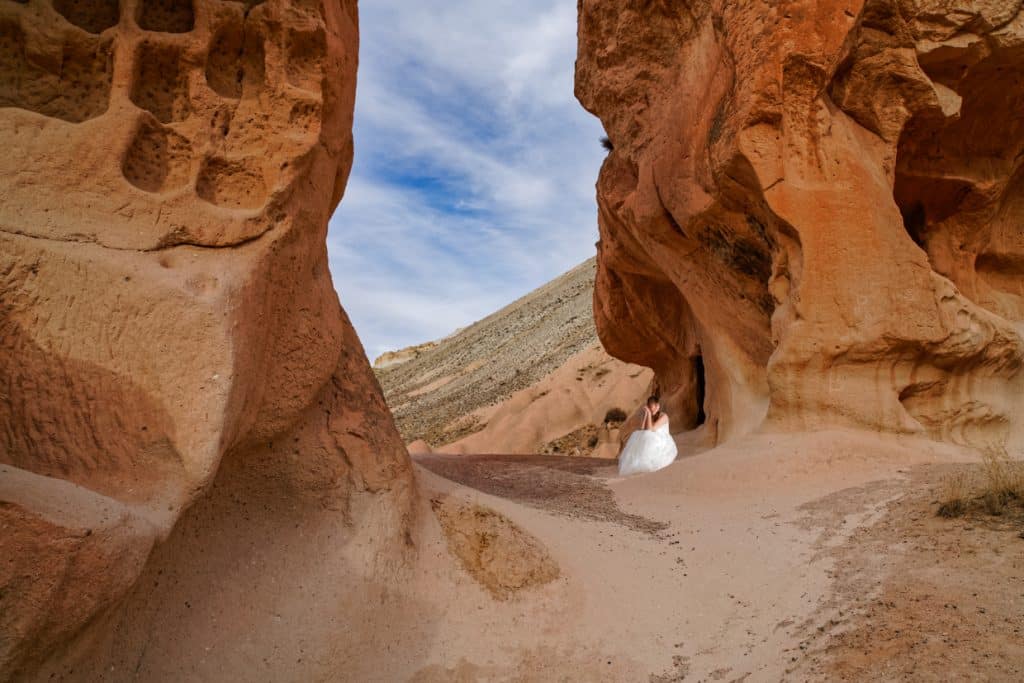
Flash compensation:
Adjusts the amount of flash light in a range of –2.0 EV to +2.0 EV. Flash compensation changes the amount of flash light only. Exposure compensation changes the amount of flash light along with the change of the shutter speed and aperture.
Especially when using Slow Sync or Rear Sync Flash modes, you might have to lower the power of the Flash to get a decently exposed image.
Red Eye Reduction:
This anti-Red Eye setting quickly fires the flash before your image capture starts, reducing the red-eye effect often seen when using the flash.
(MENU → Camera Settings → page 3)
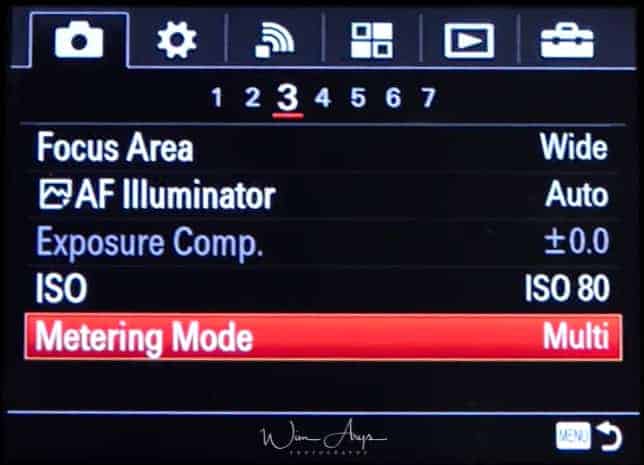
Focus area
You might think it is best to leave it on the factory ‘wide’ setting (as this uses all AF points), but for certain scenes, it is often better to use a zone or flexible spot to get it to focus on what you want.
Wide:
Wide focus area uses all focus points on the sensor. Ideal for action scenes where there is a lot of movement going on in your frame.
Center:
Focusses on whatever is centered in your images. A fail-proof way of getting the camera to focus on what you want. If you have any problems using the autofocus and are in a situation where you don’t want to miss any shots, revert to Center and just make sure you have your subject centered.
Flexible spot:
Flexible spot area selects a spot anywhere on the screen where the camera should focus. (similar to Center spot, except not.. in the center) You can set it to small, medium or large. If you want to use this focus area, set it to medium or large, as the camera will struggle to find focus when set to small (except perhaps for close-up portraits where you’d want to focus on the iris of the eye)
Focus Lock:
Shoots images with the focus locked on the desired subject in auto focus mode.
- Set the zoom/focus switch to AF/ZOOM.
- Place the subject within the AF area and press the shutter button halfway down. The focus is locked.
- Keep pressing the shutter button halfway down, and place the subject back in the original position to re-compose the shot.
- Press the shutter button down fully to take the picture.
AF Illuminator:
The AF illuminator is a little red light allowing the camera to focus more easily when the shutter button is pressed halfway. It automatically is switched off when you fully press the shutter. Leave it on.
Exposure Comp
If you find that your image is overexposed (for instance when you are shooting at large apertures for a shallow depth-of-field in bright daylight), you can tweak the exposure compensation here in a plus or minus 2 (exact EV dependent on next step) range.
ISO
You can select at which ISO value you’d like to capture your image or change the AutoISO range
I have this range set between 80-800 as this range is virtually noise free, and I don’t like the ISO performance above 1600. When shooting in low light, you might think of using a higher top value (factory setting goes up to 3200).
Tip: Autofocus will also work better at higher ISO.
Metering Mode
Metering mode refers to the way the camera reads the light and sets the exposure.
In multi, it considers the whole frame and sets exposure according to internal algorithms programmed in camera.
In spot or center, the camera only considers what is in that spot or the center (per example, if your subject is completely black, the camera will try to compensate by overexposing the image).
If you like dark or moody portraits, try setting Metering Mode to Spot or Center, and make sure your subjects face is centrally positioned in the frame. You’ll see that the exposure will be more suitable for the face than when set to Multi.
(MENU → Camera Settings → page 4)
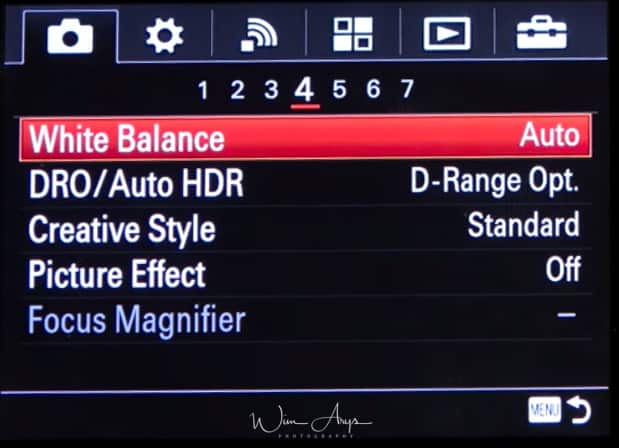
White Balance
You can either:
- Auto (default setting): The product automatically detects the light source and adjusts the color tones.
- Daylight: The color tones are adjusted for the daylight. Shade: The color tones are adjusted for shadiness.
- Cloudy: The color temperature is adjusted for a cloudy sky. Incandescent: The color temperature is adjusted for places under an incandescent lamp, or under bright lightings, such as in a photo studio.
- Incandescent: The color temperature is adjusted for places under an incandescent lamp, or under bright lights, such as in a photo studio.
- Fluor.: Cool White: The color temperature is adjusted for white fluorescent lighting.
- Fluor.: Day White: The color temperature is adjusted for neutral white fluorescent lighting.
- Fluor.: Daylight: The color temperature is adjusted for daylight fluorescent lighting.
- Flash: The color temperature is adjusted for a flash.
- C.Temp./Filter: Adjusts the color tones depending on the light source. Achieves the effect of CC (Color Compensation) filters for photography.
- Custom: Uses the white balance setting saved in [Custom Setup].
- Custom Setup: Memorizes the basic white color under the light conditions for the shooting environment.
DRO/Auto HDR
DRO:
This stands for Dynamic range optimize and analyses the contrast of your scene in real-time. It produces an image with optimal brightness and recovered shadow detail. You can use this function even while the subject is moving or during the continuous shooting.
- D-Range Optimizer: Auto (default setting): Corrects the brightness automatically.
- D-Range Optimizer: Lv1 ― D-Range Optimizer: Lv5: Optimizes the gradation of a recorded image for each divided area. Select the optimization level from Lv1 (weak) to Lv5 (strong)
Auto HDR:
This feature Shoots three images with different exposures and then overlays the bright area of the underexposed image and the dark area of the over exposed image to create a picture with an extended range from highlight to shadow.
The highlight detail in auto HDR is better than that in DRO and with reduced noise. The shutter is released three times, so using this function for moving subjects is not recommended.
- Auto HDR: Exposure Diff. Auto (default setting): Corrects the exposure difference automatically. Auto HDR: Exposure Diff. 1.0EV ―
- Auto HDR: Exposure Diff. 6.0EV: Sets the exposure difference, based on the contrast of the subject. Select the optimal level between 1.0 EV (weak) and 6.0 EV (strong). For example, if you set the exposure value to 2.0 EV, three images will be composed of the following exposure levels; −1.0 EV, optimal exposure, and +1.0 EV
Creative Style
This menu setting allows you to select the desired image processing. You can adjust exposure (shutter speed and aperture) as you like with [Creative Style], unlike with [Scene Selection] where the product adjusts the exposure.
- Standard (default setting): For shooting various scenes with rich gradation and beautiful colors.
- Vivid: The saturation and contrast are heightened for shooting striking images of colorful scenes and subjects such as flowers, spring greenery, blue sky, or ocean views.
- Portrait: For shooting the skin color in a soft tone, ideally suited for shooting portraits.
- Landscape: The saturation, contrast, and sharpness are heightened for shooting vivid and crisp scenery. Distant landscapes also stand out more.
- Sunset: For shooting the beautiful red of the setting sun.
- Black & White: For shooting images in black and white monotone.
- Sepia: For shooting images in sepia monotone.
Contrast, Saturation, and Sharpness can be adjusted for each Creative Style item. Select an item to be set by pressing the right/left side of the control wheel, then set the value using the top/bottom side of the control wheel.
- Contrast: The higher the value selected, the more the difference of light and shadow is accentuated, and the bigger the effect on the image.
- Saturation: The higher the value selected, the more vivid the color. When a lower value is selected, the color of the image is restrained and subdued.
- Sharpness: Adjusts the sharpness. The higher the value selected, the more the contours are accentuated, and the lower the value selected, the more the contours are softened.
Picture Effect
Think of this menu as an Instagram app right in your camera, with all kinds of retro filters and effects. These are only available when quality is set to Jpeg (Not in RAW). You can perform detailed settings for some of the effects by using the left/right side of the control wheel.
- Off (default setting): Disables the Picture Effect function.
- Toy Camera: Creates a soft image with shaded corners and reduced sharpness.
- Pop Color: Creates a vivid look by emphasizing color tones.
- Posterization: Creates a high contrast, abstract look by heavily emphasizing primary colors, or in black and white.
- Retro Photo: Creates the look of an aged photo with sepia color tones and faded contrast.
- Soft High-key: Creates an image with the indicated atmosphere: bright, transparent, ethereal, tender, soft.
- Partial Color: Creates an image which retains a specific color, but converts others to black and white.
- High Contrast Mono.: Creates a high-contrast image in black and white.
- Soft Focus: Creates an image filled with a soft lighting effect.
- HDR Painting: Creates the look of a painting, enhancing the colors and details.
- Rich-tone Mono.: Creates an image in black and white with rich gradation and reproduction of details.
- Miniature: Creates an image which enhances the subject vividly, with the background defocused considerably. This effect may often be found in pictures of miniature models.
- Watercolor: Creates an image with ink bleed and blurring effects as if painted using watercolors.
- Illustration: Creates an illustration-like image by emphasizing the outlines.
Focus Magnifier
Another quite handy feature if you want to check if your image is in focus. It means that you can check the focus by enlarging the image before shooting. Great for shooting in manual focus or DMF. You can also set how long the magnified image will be shown in the Focus Magnif. Time setting. (custom settings).
Press on the center of the control wheel to enlarge the image and select the position you want to enlarge using up/down/left/right side of the control wheel. You can change the magnifier scaling in two steps by pressing in the center, and close the focus magnifier mode and return to the normal shooting display by pressing three times
You can change the magnifier scaling in two steps by pressing in the center, and close the focus magnifier mode and return to the normal shooting display by pressing three times.
(MENU → Camera Settings → page 5)
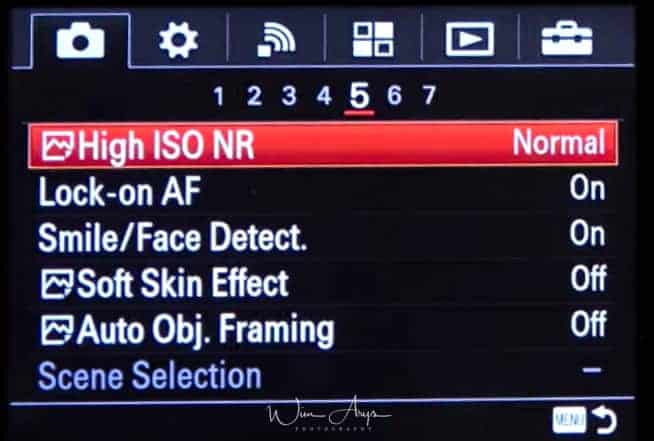
If you’ve stumbled on my guide trying to find where to turn on Long Exposure noise reduction, I’ll have to disappoint you. Although one on the most requested features, the DSC-HQ90V does not have this functionality.
High ISO NR
Here you can select the amount of noise reduction applied to images with high ISO settings (when quality is set to jpeg). As Sony has rather aggressive noise reduction, I would chance it to Low. (if not, you run the risk of getting paint-like, smeared images at higher ISO values)
Lock-on AF
This is a very powerful autofocus feature. When turned ON, it allows you to track a subject. In the iAuto mode, you can access this feature (when turned ON and the camera is set to AF) by pressing the Center button of the multi-controller. You’ll see a square on your screen, then center your desired tracking subject and the camera will continue to track it, even when it exits your frame and reappears.
Smile/Face Detect
This is another powerful feature. It can be set to automatically detect on focus on faces and enable a function called Smile Shutter. When the latter is enabled, the camera will automatically capture an image when a smile is detected. Did I hear you say Selfie? Yes, it’s the ultimate selfie tool.
Soft skin effect
Sets the effect used for shooting the skin smoothly in the Face Detection function. I don’t like the results, so on my camera, it is turned off.
Auto Object Framing
When enabled, the Sony HX400V will automatically crop your captured image to what it deems best. Meaning it will cut the picture for a nicer composition. A nice feature if you don’t want to bother too much with the technical side of photography.
Scene Selection
Allows you to shoot with preset settings according to the scene.
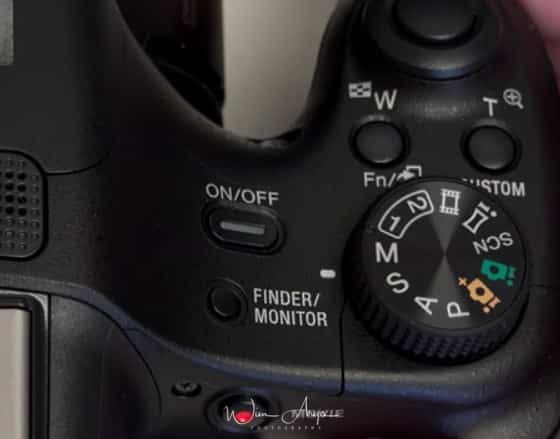
- Set the mode dial to SCN (Scene Selection).
- MENU → (Camera Settings) → [Scene Selection SCN] → desired mode. When [Mode Dial Guide] is set to [On], you can select the desired settings after you have changed the position of the mode dial.
These presets are available:
- Portrait: Blurs background and sharpens the subject. Accentuates the skin tones softly.
- Adv.Sports Shooting: Allows you to shoot subjects with fast movements, such as sports. While the shutter is pressed halfway, the movement of the subject is predicted and the focus will be adjusted.
- Landscape: Shoots the entire range of a scenery in sharp focus with vivid colors.
- Night Scene: Shoots night scenes without losing the dark atmosphere.
- Hand-held Twilight: Shoots night scenes with less noise and blur without using a tripod. A burst of shots are taken, and image processing is applied to reduce subject blur, camera shake, and noise.
- Night Portrait: Shoots night scene portraits using the flash.
- Anti Motion Blur: Allows you to shoot indoor shots without using the flash and reduces subject blur. The product shoots burst images and combines them to create the image, reducing subject blur and noise.
- Pet: Allows you to shoot images of your pet with the best settings.
- Gourmet: Allows you to shoot food arrangements in delicious and bright colors.
- Beach: Allows you to shoot scenes on the beach in bright and vivid colors even under the sunlight.
- Snow: Allows you to shoot clear images, preventing sunken colors in snowy scenes or other places where the whole screen appears white.
- Fireworks: Allows you to shoot images of fireworks in all their splendor.
- Soft Skin: Allows you to shoot images of faces with a smoother look.
- High Sensitivity: Allows you to shoot still images even in dark locations without using the flash, and reduces subject blur. Also allows you to shoot dark movie scenes more brightly.
(MENU → Camera Settings → page 6)
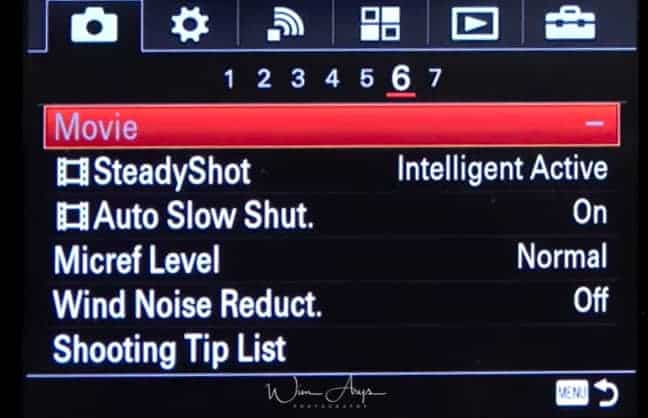
Movie
You can adjust the shutter speed or aperture value to your desired settings for recording movies. You can also check the image angle before shooting.
- Program Auto: Allows you to shoot with the exposure adjusted automatically (both the shutter speed and the aperture value).
- Aperture Priority: Allows you to shoot after adjusting the aperture value manually.
- Shutter Priority: Allows you to shoot after adjusting the shutter speed manually.
- Manual Exposure: Allows you to shoot after adjusting the exposure (both the shutter speed and the aperture value) manually
SteadyShot (for movies)
Sets SteadyShot when shooting movies.
Here you have three options:
- Intelligent Active: Provides the most powerful SteadyShot effect. I set it to this.
- Active (default setting): Provides a more powerful SteadyShot effect.
- Standard: Reduces camera shake under stable movie shooting condition.
Auto slow shut. (also a movie setting)
Sets whether or not to adjust the shutter speed automatically when recording movies if the subject is dark. Less light always means a longer shutter time in order to get a correct exposure. As when shooting stills, you might get some blur when you use this feature.
On: The shutter speed automatically slows when recording in dark locations. You can reduce noise in the movie by using a slow shutter speed when recording in the dark.
Off: The recorded movie will be darker than when On is selected, but you can record movies with smoother motion and less object blur.
Micref Level
You can select the microphone level for movie recording to Normal (for dialogue) or Low (for concerts etc).
Wind noise reduct.
Sets whether or not to reduce wind noise during movie recording.
Shooting tip list
This setting basically turns the on-screen shooting tips on or off. If you’re not fully comfortable with the camera, this is an excellent tool in order to get acquainted with all the functions and settings. Once it starts getting on your nerves, it means you know enough to turn it off :).
(MENU → Camera Settings → page 7)
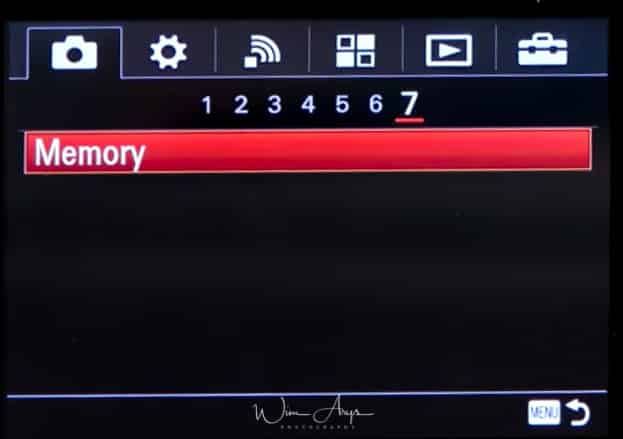
Memory
Allows you to register up to 3 often-used modes or product settings in the product. You can recall the settings using just the mode dial.
Items that can be registered:
- Shooting mode
- Aperture (F number)
- Shutter speed
- Camera Settings
- Optical zoom scale
To recall registered settings: Set the mode dial to MR, then press the right/left side of the control wheel or turn the control wheel to select the desired memory number.
To change registered settings: Change the setting to the desired one and re-register the setting to the same mode number
(MENU → Custom settings (wheel) → page 1)
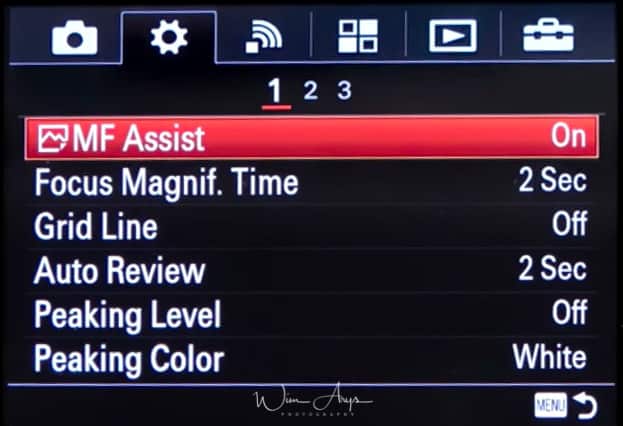
MF assist
This works in conjunction with the Focus Magnifier on Page 5 of the camera settings. You might remember that you can select the area to magnify there when using manual focus (MF). MF assist will need to be turned on if you want to use this feature.
Focus Magnif Time
You can set how long to hold the magnified area during MF assist. 2 sec, 5 seconds or no limit.
Two seconds is how I have it set up.
Grid Line
Having a grid line on your screen is a helpful aide for the composition of your image.
The human brain is hard-wired to recognize the structure, and most people find a well-composed image more eye-pleasing.
During photography history, rules have been developed on how to compose the different elements best within a scene. Many landscapes you’ll see have the horizon run through the middle of the image for instance, but this is just composition in its simplest form. Many photographers with a thorough understanding of these techniques go far beyond that.
A good starting point is using the in-camera grid to make your brain aware of the possibilities in composition.
The Rules of 3rds, Square and Diag +square are available in the Sony HX400V.
Auto Review
Select the amount of time the camera displays your image directly after capturing the image. 10, 5 and 2 sec is available, or you can turn this feature OFF if it annoys you.
Peaking Level
- Peaking Level is a manual focusing aid that works when you have your camera set to MF or DMF.
- You’ll see a type of noise outlining the parts of your image where the focus lies; you can adjust the sensitivity to high, mid or low.
- Which setting is best depends on what lens you use, as with a sharper lens it can be configured to low, while more soft lenses benefit from a medium or high setting to clearly visualize what you’re focusing on.
Peaking Color
You can choose the color of this Peaking between Red, white and yellow. I have it set to red, as this contrasts nicely with most scenes you capture.
MENU – Custom Settings – page 2
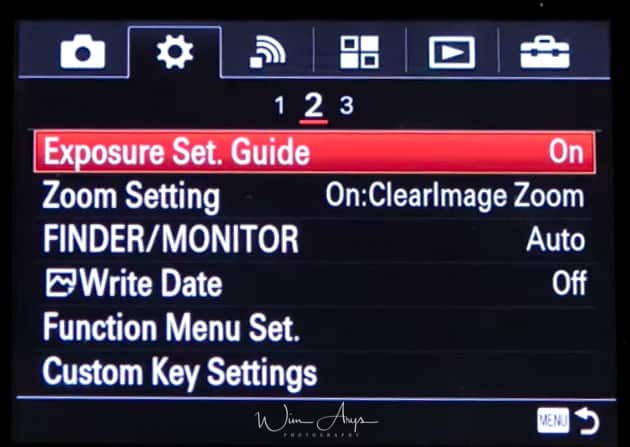
Exposure set guide
Sets the guide displayed when exposure settings are changed in the shooting screen. Excellent tool when you’re getting to know the functionality of your new camera. If you’re familiar with Sony’s feature, turn it OFF.
Zoom setting
Set to Optical zoom only, using the optical zoom capabilities of your lens. If you set this to digital zoom, the camera will be basically cropping pixels out.
Finder/Monitor
Sets the method for switching the display between Electronic Viewfinder and the screen.
- Auto (default setting): When you look into the Electronic Viewfinder, the display is switched to the Electronic Viewfinder automatically.
- Viewfinder: Switch between the Electronic Viewfinder display and the screen display by pushing up/down the pop-up finder. When the Electronic Viewfinder is pushed down, the image is displayed only on the screen. When the Electronic Viewfinder is pushed up, the screen is turned off and the image is displayed only in the Electronic Viewfinder.
Write Date
Sets whether to record a shooting date on the still image. Remember that you won’t be able to delete the date stamp on your image if it is turned On.
Function menu set
You can assign the functions to be called up when you press the Fn (Function) button.
Custom keys setting
Assigning functions to the various keys allows you to speed up operations by pressing the appropriate key when the shooting information screen is displayed.
MENU – Custom Settings – page 3
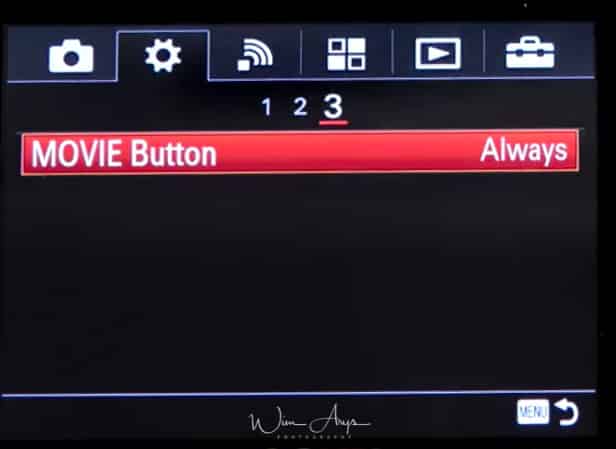
Movie button
Sets whether or not to activate the MOVIE button.
- Always (default setting): Starts movie recording when you press the MOVIE button in any mode.
- Movie Mode Only: Starts movie recording when you press the MOVIE button only if the shooting mode is set to Movie mode.
MENU – Wireless functionality – page 1
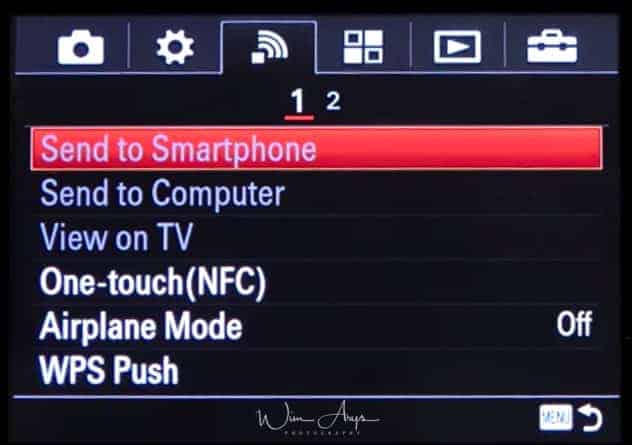
Send To Smartphone
- You can send one or several images directly to your wireless device (phone or tablet) by pressing this button.
- You can either decide to choose which images you want to transfer on the camera or on the wireless device (via the Sony PlayMemories app, available for free in the apple or android store).
- You’ll have to connect the camera via Wifi first (it makes a Wifi access point), using the instruction on the Sony DSC-HX400V screen.
- It works just like connecting to any other access point with your phone or tablet.
- You should do this as quickly as possible, just to get it out of the way.
- When your phone has wirelessly connected to the camera once, and you’ve entered the password, it will remember this, and make it a lot faster to connect later.
Send to Computer
You’ll need to physically connect the computer to the camera using the supplied USB cable, and you can push selected pictures to your Sony PlayMemories desktop software (installed from the CD or downloaded from their website). This can even be set up to continue pushing images after the camera has turned off.
View On TV
If you have a Wifi-enabled TV, you can view images and slideshows directly from your camera through your home wireless network.
One Touch NFC
Enables Quick, one-touch connection (as opposed to first accessing the camera’s wireless network and then navigating to the Playmemories app) with NFC (near-field communication) capable devices.
I have not tried this (as my iPhone does not have NFC) but it looks a lot easier to use.
Airplane Mode
Disables all wireless functionality, just like airplane mode does on your phone.
WPS Push
If your access point has the WPS button, you can register the access point to the camera easily by pushing the WPS button.
MENU – Wireless functionality – page 2
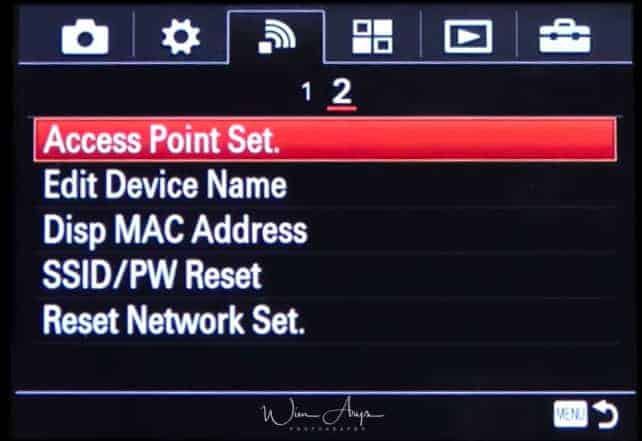
Access Point Set
Here you can setup an access point for your camera to the internet.
It enables the Sony DSC-HX400V to install PlayMemories apps from the internet directly. Works just like setting an access point (WiFi connection) on your phone.
Edit Device name
If you wish, you can change the name of the Device Access point perhaps to make it easier to identify which A6000 is yours in certain situations.
Disp MAC. address
Displays the MAC address of your Sony DSC-HX400V.
SSID/PW reset
The Sony DSC-HX400V shares the connection information for Send to Smartphone and Smart Remote Embedded with a device that has permission to connect. If you want to change the device that is permitted to connect, reset the connection information.
Reset Network set
Resets all the network settings to default settings.
MENU – Playmemories settings- page 1
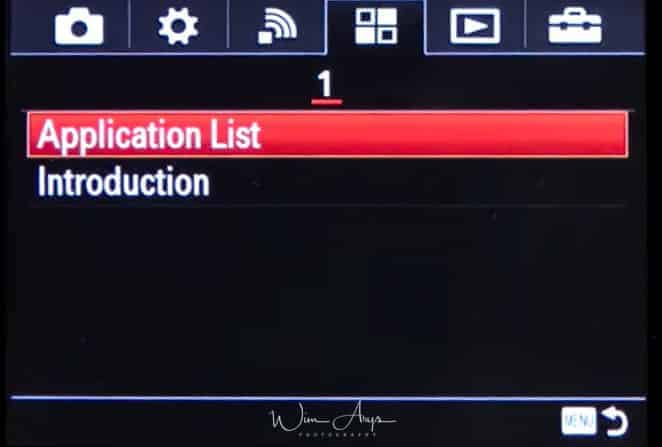
Application List
You’ll find The Smart remote control camera app (wich allows you to use your phone as a remote control via PlayMemories phone app for iPhone and Android) and the Playmemories Camera app here.
You can access your online PlayMemories account here, or create an account (once you’ve set up your camera connection with your Wifi network).
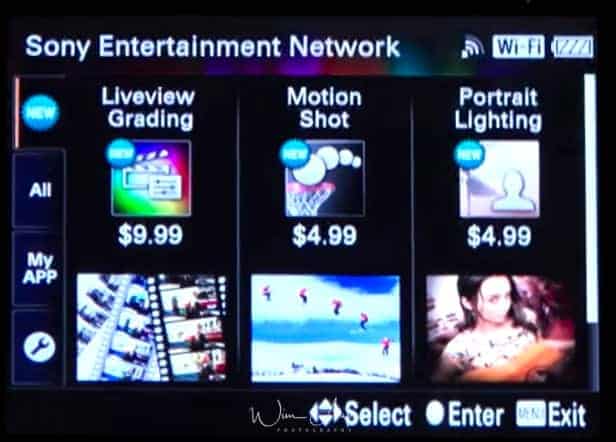
You’ll also be able to download new apps available for purchase in the Sony Playmemories online app store like the Time-lapse and smooth reflection app.
If you do not want to connect your camera to the internet, you can always install new apps (and updates) if you connect the camera to your Mac or PC with the supplied USB cable, using the Sony PlayMemories desktop application.
Introduction
You’ll find information about the service and available countries and regions here.
MENU – playback options – page 1
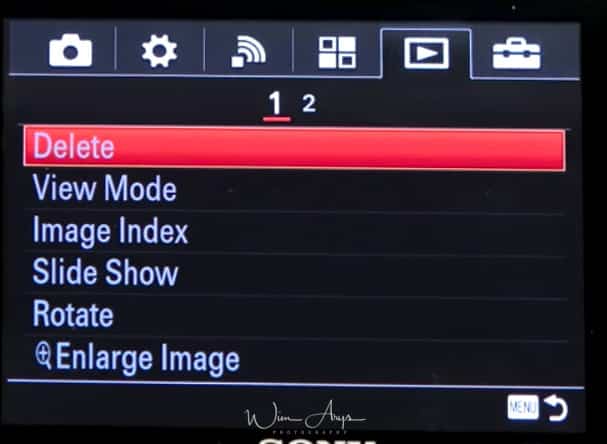
Delete
Delete on or multiple images stored on your SD card.
View Mode
select how the camera will arrange captured images in the viewing browser.
Image Index
Select whether you want the image browser to display 12 (larger) or 30 (smaller) images per page.
Slide Show
Select whether you want the camera to repeat slideshows when all pictures are viewed or not, and choose the interval between slides.
Rotate
Change the orientation of images in-camera.
Enlarge Image
Select an image and enlarge a portion of that image. Useful for checking details and focus.
MENU – playback options – page 2
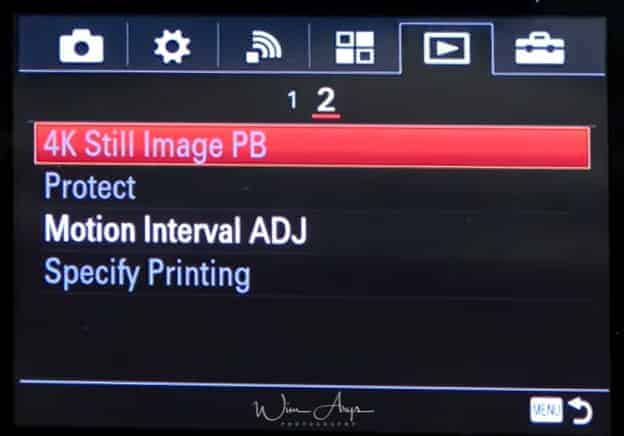
4K Still Image PB
Outputs still images in 4K resolution to an HDMI-connected TV that supports 4K.
Protect
Protect images (selectable or per date) from accidentally being erased.
Motion Interval ADJ
Change the interval of the image tracking of the subject’s motion in high-speed, like a stroboscopic image.
Specify Printing
Specify Printing is a feature that allows images to be marked for printing later. Registered images are displayed with the DPOF mark. (DPOF stands for Digital Print Order Format)
MENU – Setup – page 1
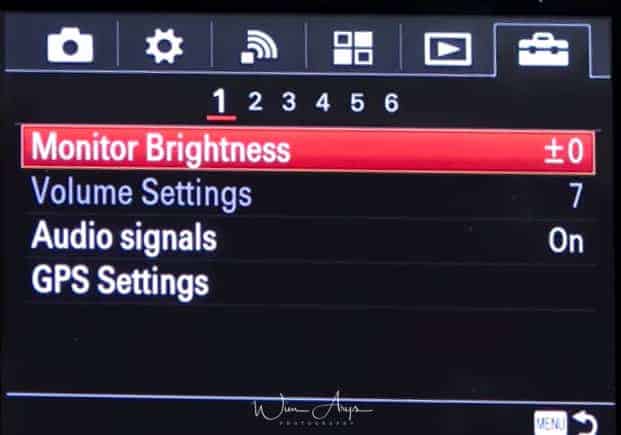
Monitor Brightness
Manually set the Monitor brightness (recommended leave to zero) or change to a brighter setting for Sunny Weather.
Volume settings
Change the playback volume for recorded video or demos.
Audio Signals
You can turn off audio signals like the beep when te camera achieves focus. Useful if you want a more stealthy operation (although you’ll still hear the second curtain shutter).
GPS signals
You can record the location information with the images when the built-in GPS sensor of this product can acquire the location information. Using the software PlayMemories Home, you can import the images recorded with the location information to a computer and enjoy viewing them on a map which shows their shooting location. Refer to the Help of PlayMemories Home for details.
- On: The GPS function is activated.
- Off: The GPS function is turned off. The status icon on the screen may differ depending on the conditions of the signals emitted from the satellites.
- No icon is displayed: GPS is set to Off or an error has occurred.
MENU – Setup – page 2
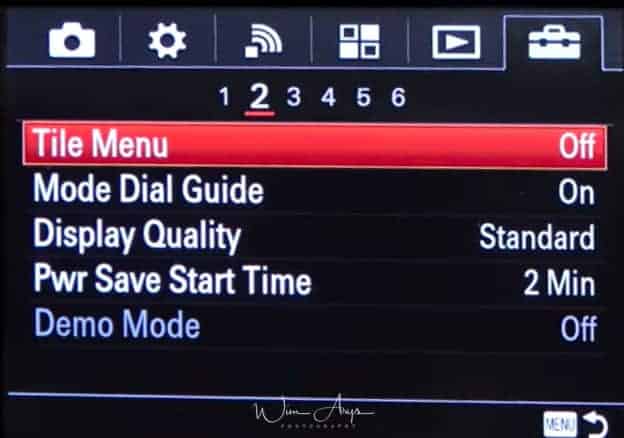
Title Menu
choose between tiles or a tiled front page when accessing the MENU or a direct tab style menu layout.
Mode Dial Guide
You can display the description of a shooting mode when you turn the mode dial and change the settings available for that shooting mode. Handy when you are learning how to use the Sony DSC-HX400V.
Delete confirm
You can set whether Delete or Cancel is selected as the default setting on the delete confirmation screen.
Display Quality
You can change the display quality. Set to standard to preserve battery life.
- High: Displays in high quality.
- Standard: Displays in standard quality.
Pwr Save Start time
Selects the time it takes for the camera to go into sleep mode if you don’t use it.
Demo Mode
Demo mode is only used in retail stores for demonstration purposes.
MENU – Setup – page 3
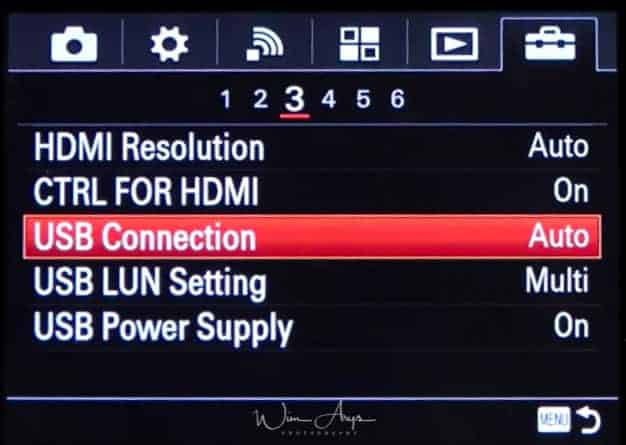
HDMI Resolution
When you connect the product to a High Definition (HD) TV with HDMI terminals using an HDMI cable (sold separately), you can select HDMI Resolution to output images to the TV.
- Auto (default setting): The product automatically recognizes an HD TV and sets the output resolution.
- 1080p: Outputs signals in HD picture quality (1080p).
- 1080i: Outputs signals in HD picture quality (1080i).CTRL for HDMI.
CTRL for HDMI
When connecting this product to a BRAVIA compatible TV using an HDMI cable, you can operate this product by aiming the TV remote control at the TV.
Either ON or OFF.
USB connection
Selects what will happen when you connect your camera to your PC or MAC.
- Auto (default setting): Establishes a Mass Storage or MTP connection automatically, depending on the computer or other USB devices to be connected. Windows 7 or Windows 8 computers are connected in MTP, and their unique functions are enabled for use.
- Mass Storage: Establishes a Mass Storage connection between this product, a computer, and other USB devices.
- MTP: Establishes an MTP connection between this product, a computer, and other USB devices. Windows 7 or Windows 8 computers are connected in MTP, and their unique functions are enabled for use.
USB LUN Setting
Improves compatibility with external devices by limiting the functions of the USB connection.
Older devices that are not able to connect to the camera might work when set to single. Otherwise, use Multi.
USB power supply
You can charge theSony DSC-HX400V via USB. This setting sets whether to supply power via the micro USB cable when the product is connected to a computer or an USB device.
MENU – Setup – page 4
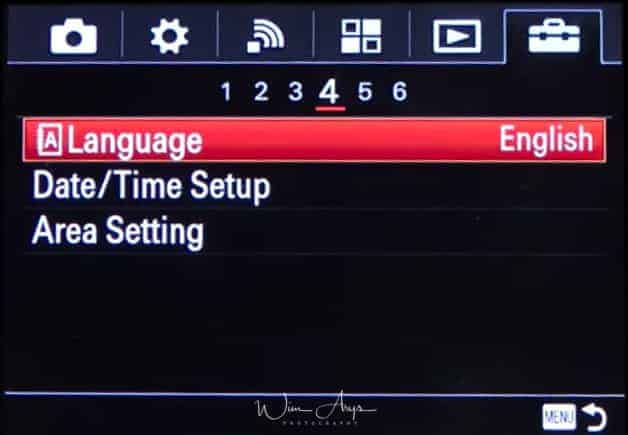
Language
Set your preferred language. The advantage of setting it to Eglish is that you’ll find much more information online when you need any troubleshooting.
Date Time Setup
Change date, time, date format and Daylight savings time.
Area setting
Select your region, or change region when abroad, the camera will automatically change time and date for you.
MENU – Setup – page 5
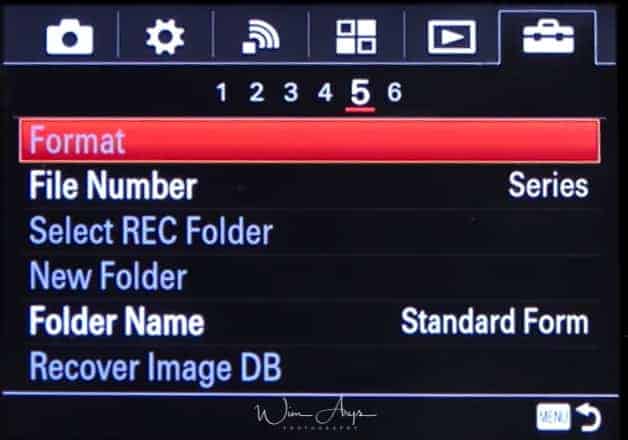
Format
Format your SD card before use; this will erase any images still on the memory card.
File Number
Number your files according to a number of shots or reset it to start from 1.
Select REC folder
Selects where the camera will store newly captured images.
New Folder
Make a new folder for easily organizing events and locations
Folder name
Choose whether to have folder names in standard form (DSC) or create a new one by date. Setting folders by date will make organizing your images easier.
Recover Image DB
If you have a storage card error, you can try to rebuild the database to possibly retrieve lost images.
MENU – Setup – page 6
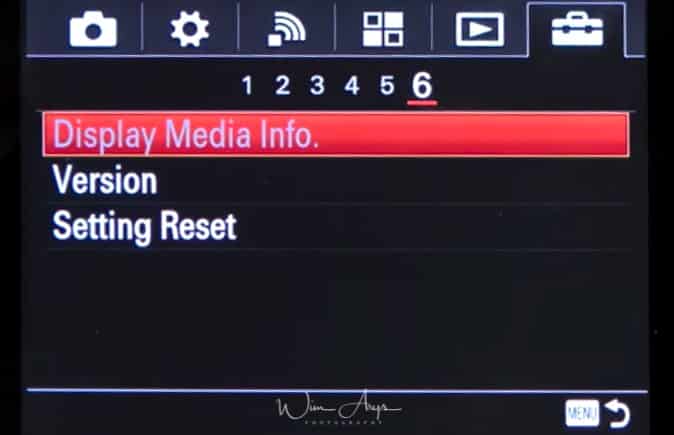
Display media info
Displays the recordable time of movies and the number of recordable still images for the inserted memory card.
Version
Check what version of the operating system your camera and lens are running. Sony sporadically releases updates with new features, so it might be worth checking if any new firmware versions are available.
Setting Reset
Fully resets the camera to factory settings.
In the next chapter, I’ll go over all the functionality that I find most useful
Mode dial functions: what’s the difference between intelligent and superior auto?
Intelligent Auto
- This mode lets the camera detect what kind of scene you are photographing. It switches to the scene setting it finds most appropriate, including aperture, shutter speed, ISO, and AF mode.
- These different scene settings are the same you’ll find manually selectable in SCN mode.
- All Sony cameras do a good job at detecting scenes, although the advanced photographer will prefer to shoot in Aperture, Shutter priority or fully manual mode in order to have more control over things like depth-of-field, movement, and focusing area.
Superior Auto
- Does the same scene recognition and (when the camera decides it is appropriate) adds hand-held twilight, anti-motion blur, and backlight correction HDR in order to optimize dynamic range, movement and exposure.
- It uses multiple images shot in close succession at high quality and combines them into one jpeg. Works well on stills but should not be used for movement.
Peaking
Peaking enhances the outline of in-focus ranges using a specific color in Manual Focus or Direct Manual Focus shooting.
- This works in MF and DMF focusing modes
- MENU → (Custom Settings) → [Peaking Level] → desired setting.
- It displays a color selectable noise in the regions where the focus is on.
- A low setting is recommended in enough light on the Sony DSC-HX400V.
- In dim light, you might need to go to medium to get a good idea of where the focus is at.
Lock-on AF
Depending on the options selected in [Focus Area] or [Center Lock-on AF], the available functions varies when pressing the key. Found in the Focus Area setting. When you press the key when the [Focus Area] is set to [Wide] or [Center] and [Center Lock-on AF] is [On], [Center Lock-on AF] will activate. The camera will automatically focus while pressing the key when the [Focus Area] is [Wide] or [Center], [Focus Mode] is set to other than [Manual Focus], and [Center Lock on AF] is set to [Off].
- When you press the center button, the camera detects the subject positioned in the center of the screen and continues to track the subject.
- MENU → (Camera Settings) → [Lock-on AF] → [On]
- Align the target frame (A) over the subject and press in the center of the control wheel. Press again to stop tracking.
- If the camera loses track of the subject, it can detect when the subject reappears on the monitor and resume tracking.
- Press the shutter button fully down to shoot the image.
Smile/face detect
When set to On, The Sony DSC-HX400V will automatically detect and focus on faces. This is a very powerful feature.
Go to MENU → (Camera Settings) → [Smile/Face Detect.] and select either:
- On : Automatically selects a face to be brought into focus.
- Smile shutter: Automatically detects and shoots a smile. When the Smile/Face Detect. is set to Smile Shutter, you can select the Smile Detection Sensitivity from Slight Smile, Normal Smile or Big Smile.
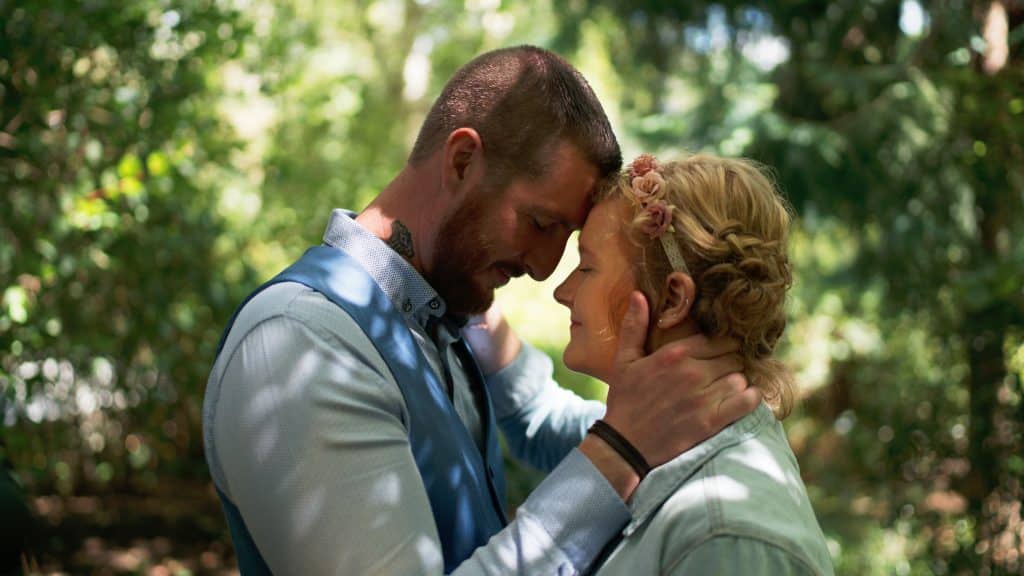
Conclusion
Although the Sony DSC-HX400V compact camera is deemed an enthusiast oriented or ‘beginner’ camera, you’ll find that it has many of the advanced features of the Sony RX and even ILC line. An advanced manual like this can help you make the most of it, and make you a better photographer. If you’re just starting out in photography, I would suggest taking a look at the SCN or Scene selections that give you a good starting point for any type of activity or subject you’d like to shoot.
There are many hidden features and functions like this inside the Sony HQ400V, and I would suggest taking some time to learn some of them. I know that and advanced guide like this looks daunting at first, but you’ll soon get the hang of it by easily following along with your camera’s menu system.


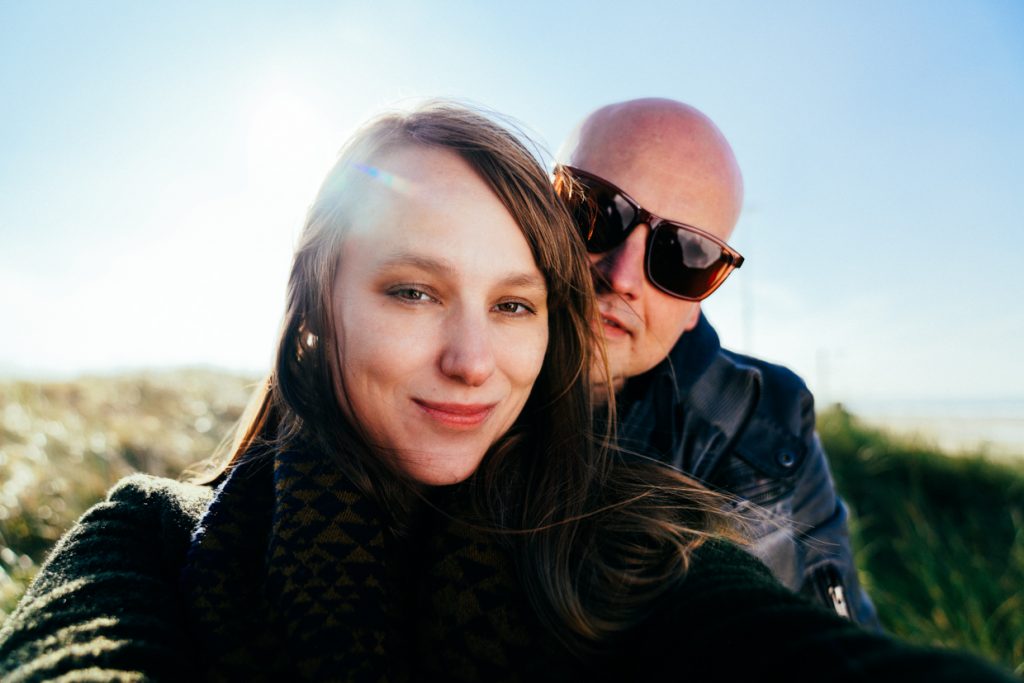
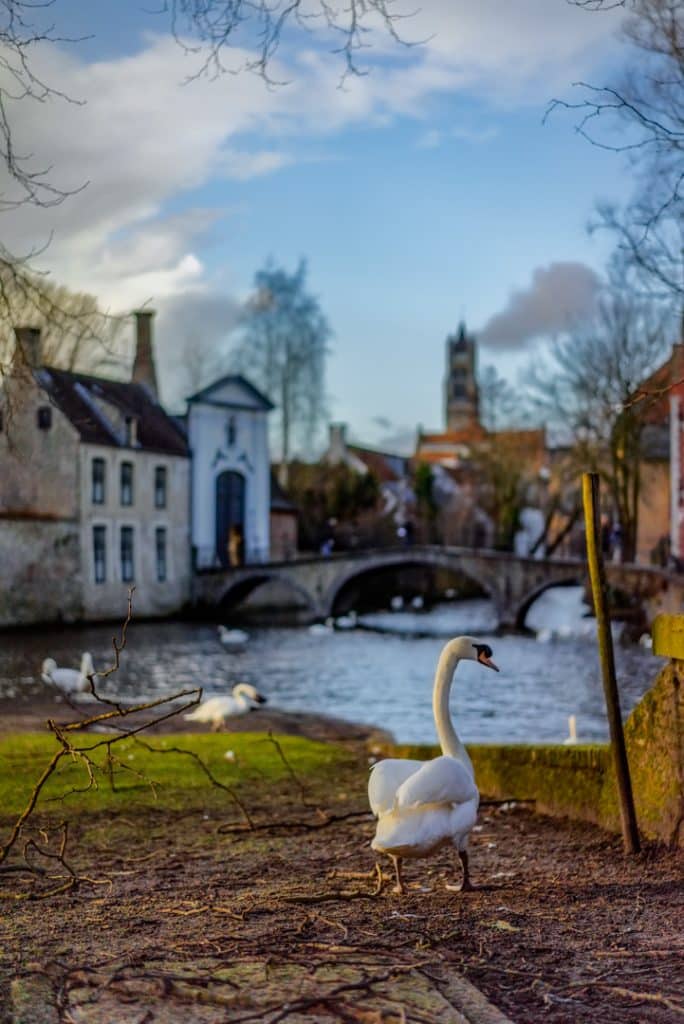
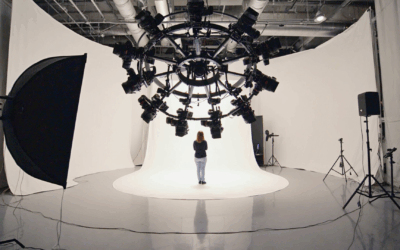

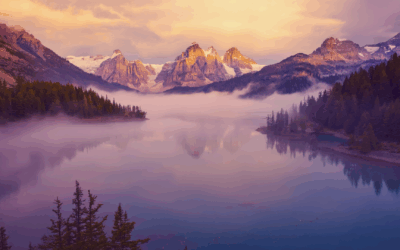
Hi
I have just bought the Sony hx400v and found your tutorial very helpful, is it available as a pdf as I would like to keep this on my tablet for reference.
Well done on a excellent piece of work.
Hi Aaron, I don’t have this option available yet, but if there is enough demand, I’ll look into it.
thank you, could you please tell me how to take along exposure photo, I bought a remote shutter release , but the camera somehow would not allow me to do it. this model camera I know does not have a bulb feature, but I was let to believe that a remote shutter release would allow me to have a long exposure , confused
Ho Brian, you can take long exposures up to 30 seconds, but since this camera does not have a bulb mode, it’s not possible to go beyond that. You can try the smooth reflection app to combine multiple shots, it can automatically merge from 2 to 256 pictures.
Hi, how do i put a date and time stamp on my photos.
It is possible….Just go to the “WIRTE DATE” option in Setting -> 2nd menu -> 2nd page…
I love my HX400V (it’s actually my 2nd one) …what is the best way to eliminate fencing or mesh in low light? Thanks
Hi Patti, do you mean when shooting through fences? Or are you talking about high ISO artifacts and problems with artificial light? Best, Wim
Yes, shooting through fences and mesh-thank you.
I am trying to figure out how to do a beautiful shallow depth of field and am not getting anywhere unless I have the camera super close to the subject. Any suggestions? Thanks for your help.
Hi Marjorie, I think you’ve reached the limits of what this camera can do. As you mentioned, getting your subject as close as possible will get you the best results, and also keeping the aperture as open as possible. Best, Wim
Hi Wim
Great guide thank you.
How do you register someone’s face for autofocus recogniton please?
Hi Malcolm, I’m sorry but the HX400V is no able to actually register faces. You can however turn on face recognition. Hope that helps. Best, Wim
Hallo,
I have just purchased the Sony HX400V. I am so pleased to have found your tutorial on the internet, this is so very helpful in enabling me to get so much more out of this camera.
Thank you very much.
PS: I hope you enjoy your wel deserved coffee.
Patrick
Hi Patrick, thank you very much :).
Greetings Wim, wonderful work on this manual for the Hx400. What is the best setting or technique for shooting in Macro for Flowers or Insects etc. I know other Sony cameras have a Macro setting but the Hx400 does not appear to have one. What do you suggest?
Hi Will, well you can get as close as 1 cm to the lens, so it’s definitely possible. As always with macro, you depth-of-field or the part that is in focus will be very thin at large apertures (when using natural light), that’s why many photographers prefer to focus stack. I.e. take different shots focused to the front and to the back and blend these together in an app like Photoshop afterwards.
Will, there does appear to be a macros mode for the camera. If you use full auto mode or intelligent auto, if you are close enough to a target you’ll see it engage “macros” mode, with the telltale flower symbol on the top left of the screen. Unfortunately, this mode does not appear in the scene selector mode.
You can achieve the same results by switching to full manual mode and adjusting the aperture and shutter yourself. But it is important to note, you will have to zoom the lens out fully and get physically close to a subject for the best shot.
With all cameras, as you zoom in the F-stop increases (higher aperture number). This makes it harder to focus on a target without being a minimum distance away from it.
I played with my hx400 a bit and found that if you want to get a macros shot of something, the best thing to do is get as close as you can to the subject, zoom out fully, and then lower your fstop as much as possible (use aperature priority or full manual, or set the camera to intelligent auto, wait for it to recognize a macros shot, and/or adjust your focus manually).
Getting close to the subject with zoom fully retracted produced better results than stepping back and zooming in (I had cloudy day lighting to work with).
Hey! First of all, thanks for this guide. But I have a question, are you sure that this camera has the other options for the Grid Lines? Like diag + square rules?
No problem Gustavo, I wrote this guide some time ago and don’t have the camera currently. If any other readers find this, please let me know.
This is a great asset to us struggling photogaphers. Thank you for taking the time to put the guide together.
I am having trouble with the manual focus. I set the outer ring to MF but as soon as I turn the lens it does not focus. I just get some weird result in the viewfinder/rear screen, looks like the image is greatly magnified. Any ideas please. Thank you. Roy
Sounds like the focus magnifier setting is on Roy. Change it here: MENU → Camera Settings → page 4
I am not getting the pictures I had hoped with this camera. I only take still photos of sterling silver engraved jewelry. The writing needs to be clear. I take the pictures on my cover deck , placing the jewelry on drift wood and use a white reflector. With my previous camera I took beautiful pictures here. I played with the settings after reading this and I can get the color where I want it but writing is not clear. On preset settings jewelry is too blue or to yellow. Is there any advice you can give me for settings to try? I live in Canada and most the year it is cloudy. The pictures are for my website and I need them all to match in color. The ones I have on there now that don’t match were taken with this camera.
I would suggest you get a color checker passport Heather. You need a way of accurately setting your white balance.
Is there one you can recommend? I looked online but it says it is software for my computer, is that what I want? Sorry I don’t really know that that is or how to use. Can you explain?
Thank you very much for this manual.
I have just bought a Sony HX400V and i will try to follow up your tips!
Cheers
How To Switch Between NTSC and PAL?
Not possible in this model.
Hi, would you be able to walk me through how to change the exposure time on this camera? I just cannot figure out how to do it! I want to practice taking night shots for a trip to Yellowstone and would like to change it to a 30 second exposure. Thanks a lot!
Thank you for this manual. Recently, when I try to record video, the screen through the viewfinder and resulting video is too white – can barely see what I am trying to record. What do I need to do to get an accurate recording? Do I need to change a setting?
Hi Beverly, you mean overexposed? Yes definitely check your settings and if you’re not an export, make sure it’s on auto.
Hi Wim, which setting would you suggest for starry sky pictures?
Hi Etienne,
a fast aperture, as fast as possible, it this case f/2.8 and you need to have a shutter speed that is maximum 20-25 seconds to prevent movement of the stars. So you will need to raise ISO to facilitate that shutter speed.
Hi Wim, thanks for your guidance. Please will you bother to let me know whether I can focus on manually one of different objects to get that particular object focused? Thanks.
Hi Nirmal,
sure, there is a slider on the left of the lens.Slide it down to the last option, MF.
With my other sony 300 i was able to trim and edit a picture withmy card in the camera. I cant find a trimming tool in the 400
I am missing this as well. SO disappointing!
hello sir
i have bought dsc hx400v in this year it was all good but day before yesterday when i was making video then i realized that the quality of image has gone change(it is dark and patchy) i have reset it and change the brightness but it didn’t work out. plzzzzz tell me the exact setting that what should i do?? i was hopeless but when i saw your link on facebook it seems like you are master please help me
Hi Sana, I think you’ll need to contact Sony customer support for this. Good luck, Wim
Ladies and gentlemen:
Excellent manual! Thank you so much, Wim!
1. There is (now) a function “Write Date” on page two of the “Custom Settings” item of the “Menu”.
2. I found no way to write/save/show the GPS-coordinates of the place where the photo was shot on the picture or its data file.
3. If this feature does not exist the DSC-HX400V is utterly useless and, therefore, worthless for all of my purposes and should not be advertised as a “GPS Camera”.
Best regards,
Matthias B.
Hi Matthias,
firstly, Write date is in fact already in this guide.
Secondly, the HX400V does have a built-in GPS.The information is stored in the EXIF data. You do have a few tools that can extract this data for you like this one:
https://sno.phy.queensu.ca/~phil/exiftool/
or for a more visual representation:
https://www.pic2map.com
I know there is an EXIF editor for iPad which allows you full access to this data. And perhaps there are a few photo editors that still give you this info directly too. Good luck.
Hello Matthias
I have just bought this camera and am in desperate need to retain yourguide on this cameraman my iPad. Is it possible please to send me a PDF of your guide to me please? Secondly I tried to take pictures out of the airplane window of mountains and they were awful . It maybe because I have a polorised lens cap fitting Onondaga there was couloured marks all over the photo. Can you assist me please
Hi Gillian,
I currently don’t have a pdf available. In regards to your issue, is it possible to remove this cap? Best, Wim
Hello Again,
How well does the Sony Hx400v work with post processing software like Lightroom. I know that most people who use LR are editing Raw Files but being that the Hx400v only does JPEG & JPEG fine, I wanted to know, would it make sense to invest in LR? Currently I am doing minimal post processing on my Ipad , IOS apps and the Playmemories Online apps and web. Can effective post processing be done with Light Room on this camera?
Hi Will, good question. There is still a lot you can do with a Jpeg in terms of processing. However I don’t think that it’s a good idea to spend this much money on a subscription every year. If you need an image editor with library functionality, have a look at Luminar. But wait until tomorrow when their Black Friday deal starts ;).
Yes,
Invest in Lightroom, you will not be sorry…Julian
Thanks so much for writing this up. Quick question about aspect ratio and sensors: You list the various choices for aspect ratio along with the megapixels and actual resolution scale for each, and you write “(recommended)” next to 4:3, which seems to take advantage of the full megapixel and resolution capability of the camera. But then in the paragraph below you list 3:2 as the ratio for taking advantage of the “full sensor”. But the 3:2 ratio lists a smaller number of pixels used in the photo, which I would think would indicate that it is NOT using the full sensor. Rather it appears the 4:3 ratio uses the maximum capabilities of this camera sensor.
Was the comment about using 3:2 a typo? Or if 3:2 does indeed use the full scale of the sensor, can you please explain why that would be preferable when it actually results in a smaller number of pixels to work with.
Thanks again for writing all this up, I was reading the Sony manual and wishing it listed specifics like this.
Hi Robert, yes definitely that should off course be 4:3 as these are the dimensions of the sensor. I’ve amended this in the post. You should also be aware that if you shoot RAW it does not really matter. It might load in another aspect ratio but the full 4:3 sensor readout is recorded.
Hi there,
excellent overview. many thanks
I have a question though.
Recently away. Took loads of pics but then suddenly screen said “no card”
opened back. card was there but had popped out. pushed back in and it popped out again
indicating that the card was full.
Touble is I have lost a load of photos that I could see after I had taken them. Did a text. Took out card and took a pic. Could see it when I looked back but now I can’t nor my other lost pics.
Is there not an internal storage on this camera and if so how do I access it.
I am home and have plugged camera in to computer without card in it but there is nothing
Hi Karen, the camera itself has no internal storage. I would guess that your SD card was corrupted when it was ejected. When a card is full, it does not eject automatically by the way, in fact there is no such system that does this in the camera at all. When a card is full, you won’t be able to take any more pictures, that’s all that will happen.
It could be possible to recover your lost images from the corrupted SD card, if the photos are important. Firstly, don’t try to format the SD card or take more pictures with it.Secondly, download software like RecuePro from Sandisk (there are many alternatives too), and run that on the card to see if your photos are recoverable.
Hi – I am a beginner with photography, and I really enjoy the way this camera works for me. Just one thing that I have noticed – when I am trying to do a night shot , like of the full moon, I get this ‘red ghosting’ almost like a floating reflection of what is in the frame? Can you please enlighten me as to how to eliminate this, what am I doing wrong? Thank you so much.
Hi Kath, I would guess that these are artefacts of a high ISO setting. Use a tripod, set the Iso to 100 and try again. best, Wim
Thank you so much for this! I am new to taking sports photos and I’m not being very successful with this camera. I thought everything would be automatic if I placed it on sports mode, but my pictures were all blurry. Can you help me know how to best set the camera?
for action photography, set your shutter speed to around 1/2000 second, that should be sufficient to freeze motion.
Hi,
My camera only seems to go to 1/4 second. I want to take night shots and go to 20 seconds. How can I get it to go longer. I put it in manual mode and scrolled the wheel to slow the shutter speed but it stops at 1/4. Can you please help me out as to why it will not go longer. Thankyou
Hi Gill, unfortunately there is no bulb function on this camera.
Hi, it is a very late response but I have been struggeling with the same issue (maximum of 1/4 second shutter time in manual mode). Since this is the only place I saw someone with the same problem ánd I have found the problem/solution, maybe it helps someone in the future.
Since I suspected it had to be a setting which blocked it, I ended up restoring to factory settings. And indeed, 30 seconds became an option! I then put back the settings one by one to see which one caused it. Turned out to be the DRO/Auto HDR setting. As soon as you choose Auto HDR, the maximum becomes 1/4. Which makes sense, but with all the settings I simply did not notice it. So if you want a longer shutter time: choose DRO auto. Hope it helps someone in the future!
Thanks for posting this Marleen.
Hi,
Is there a way of turning off the ‘beep’ when taking a photo with the Sony DSC-HX400V please?
This camera does not have a silent mode Linda.
beep sound can be turned off completly
but shutter sound still slightly noticeable
menu 6 (setup)
option audio signals
i love this manual, thanks Wim
thanks, it’s always nice to get some feedback Harold.
Hello
I am considering buying this camera and I am wondering if the Camera has a Level Guide to assist in keeping your shots level
I ook forward to your advise.
Kind regards,
Charles May
I believe so yes Charles.
Hello. I purchased the Sony Cyber-Shot DSC-HX400V Wi-Fi Digital Camera last year for a music festival and did so at the last minute and didn’t really understand my options for the camera settings. This year I’ve become more familiar with the camera but still not 100% sure what would be the very best setting for capturing live musical stage performances. Can you help set me straight on that because everything you’ve added here has been stop on great. Someone mentioned using a/the burst mode which I didn’t seem to find during my research. Thank you!
Hi Jim, you’re looking for ‘drive mode’ on the camera settings page 2. This should be set to “Cont. Shooting”.
My Camera Sony DSc Hx400v Pictures taken are not clear, During Zooming the Pictures in PC it Blurs and not clear, Pictures Faded when Zoom.
Would love this manual to be a pdf so I could download it and keep it on my camera to read when I need help. Thanks for all your help.
Working on this option.
Good day Wim,
2 questions. As Barb asked on 8/24, can we crop then enlarge a portion of a picture in camera. Could do this with the dsc hx 100.
Also, can we capture a single frame from a movie to then print. Again a function in my old dsc hx100
Thanks
Jeff
As far as I know, this is not possible Jeff.
Hi wim
Asking for my daughter…Is it possible for the camera to record movies longer than (I think) 10-15 mins long? At the moment it stops around 10 mins and she has to start it again.
Hi Karl, no I’m sorry this is not possible. It’s either a legislative restriction, in order for them to be able to sell it as a still camera and not a video recorder (taxes) or a safety feature against overheating.
Thank You for the advice. It is very helpful.
This article is a godsend to someone like me, and so is this camera. I really have not much interest in photography or things technical. But I am an avid bird watcher, and the cybershot Hx400v fits perfect for my needs. I want as simple as possible to get a decent photo of a bird either because it’s uncommon or I can’t ID it. The optical zoom 50x is fantastic. But, having just purchased it recently, can you or anyone inform me how to wipe out those half dozen Display Setting icons from my viewfinder (I use only the viewfinder) which trash my focus on the subject. I want to see my subject that I’m photographing when focusing, not all those icons. Appreciated.
Hi Jeff, have you tried pressing the multi selector (that round button on the back) up? This should scroll you through the available screen and EVF layouts.
Will do. Thank you. Please disregard my follow-up question on May 27, if posted.
Wim,
Is there any way to eliminate those display setting icons that saturate in my viewfinder (I use only the viewfinder) and obstruct the subject every time I focus. There are some 12 of these icons. I’d like to a least reduce seeing them to 3 or 4. Quite a distraction when focusing.
Thank you.
Hello Wim,
I’ve been using my Sony Cybershot DSC-Hx400v since purchasing last month and am very satisfied. I’m have little in photography, but as a birdwatcher, it’s utility for me is documenting birds of interest. I find that on very clear sunny days (in Intelligent Auto and AF), my focus becomes blurred when pressing the shutter halfway down. Yet, in other locations on the same day, the focus is pristine. Is this normal, as I believe SONY mentions this will happen in their official manual. Would you recommend a Filter for this camera, and if so, what kind? Thanks again.
Hi Jeff, that’s a strange phenomenon indeed. I have not heard about this no. I would not use any filter for birding no, since you need all the light you can get in order to have a fast enough shutter time in order not to have blurry photos. Enjoy your camera!
Hello,
Good article about the Sony Cybershot DSC-Hx400v . I’m trying to shoot dogs in action with Continous Shooting Hi and using Lock-on AF in mode M (ex: for the last shooting, I’m using ISO 125, F/4.0 and 1/1600). The autofocus on the dog seems OK but the whole jpeg picture contains a lot of noise. And so all my photos are of poor quality.
What does it come from? do you have an idea?
Have you tried using ISO 100?
Hi Wim,
Thank your for your wonderful article.
I would like to know if I could control the zoom to move smoothly from 0-50 x ( or vice-versa ) while shooting a video either from the camera or from the smartphone app.
Thank you.
Hi Mathew, I don’t think that this is possible unfortunately. You’ll need to invest in more high-end equipment if you want to do this. Best, Wim
Hi Wim,
Many thanks for your prompt reply.
Regards,
Mathew
Hi Wim,
Wonderful article and very helpful!! I have just incurred a problem with the display on my DSC-HX400v. When viewing through the viewfinder or on the digital display, the intended picture shows shimmering white throughout the scene, particularly heavy where there would normally be contrast–edges of items, etc. However, the picture itself does not show any of the “star bursty” effect. In bright daylight, it is impossible to tell what the picture will look like. Any thoughts?
Thanks,
Scott
Hi Scott, that sounds like a focussing aide. MENU → Custom settings (wheel) → page 1) Peaking level: Off.
Solved it, thank you so much!!!
This is very useful. I like the contents, since am using my camera for close up photo taking for young children. Settings has been my major challenge. Can I get this in PDF?
Ciao Will, Im attending art academy and chose also photography class. Im stuck and struggling over finding the way to obtain a simple effect of focusing on my dog (or any object) and leave everything else around him, unfocused, blur. I wanna work in manual (and is required by the professor). even i set the camera in no flash, t 1/8 and f 2,4 I have hard time to obtain the result. can u help me please?
Hi Lydia, this is not the ideal camera to do this with because the sensor is small. Like with phone cameras, you won’t see that out of focus effect either. Unless it is a software effect of course. What you can try is to have your subject as far away as possible and use the zoom lens at the long end (zoom in). This combined with a large aperture will get the most effect like this for your camera. Good luck.
I have owned my camera for almost one year and am delighted with it. My one criticism has been the lack of a decent manual by Sony.
Just ran across your site and have copied your file to a word processor. Now to read and learn!
Thank you so very much!
Hello,
is there a way to remove the processing image that the camera gives after every picture taken? Thanks for any information you can provide. Sincerely, Mitch..
Sure that’s called Auto Review: Select the amount of time the camera displays your image directly after capturing the image. 10, 5 and 2 sec is available, or you can turn this feature OFF if it annoys you.
You can find it in MENU → Custom settings (wheel) → page 1
Hi,
I’ve just bought this camera and following your tutorial eagerly.
When snapping in Manual Mode, I find that I can adjust the shutter speed by using the control dial. But, I couldn’t detect any means to adjust the aperture. How can I do so?
Thank you,
Partha
Press the bottom button on the control button on the backplate.
Wim, I am a retired pro/studio owner of some 45 years. I have your manual for my RX10mk4, and my wife again wants something to shoot with so I have the HX400v coming this week and wanted something for her. I donated the $$ and would love to have the piece you have on YouTube for the HX400v without the ads if that can be arranged.
Thanks for all the background work on these amazing cameras.
We shot Hasselblads and RZ’s in the studio for years with film, then switched our 35’s from Nikon to Canon on the start of this digital age and then sold the studio and video production studio. All the pro equipment too. So I have been shooting with the Canon SX series with the 40, 50 and 60.
About the time I was starting to look at the new technology, I was talking to one of my granddaughters who is a very advanced photographer and flyes with Delta and she impressed me to look into Sony cameras. I still thought if them as making Walkmans and TV’s. Boy was my mind changed in a hurry. At 82 years in just a couple of days, I’ve got the bug again,
Excellent guide. How do we get to chapter 2?
Thanks in advance
Mike in Mesa AZ
Great help!! Just bought the camera a month ago and have already taken some great photos! Your article will certainly help me further with a great experience with my camera!!
I have a question though about cropping within the camera. I have figured out how to zoom in on and move an image left, right, up and down but how do you save it?? If you can do all of the above, I would think you could save the image you just “cropped”. If not, why would you be able to do the above “zooming, moving left and right?
hi Lori, this zooming is a feature to assess sharpness, it’s not really cropping.
Hi, thanks for an excellent review. However, you recommend setting NR to Low to avoid “paint-like, smeared images at higher ISO values”. My problem is that all I’m getting are smeared images with extreme loss of detail when zooming in on birds. After having used a Canon SX40 I was mostly satisfied with, I was looking forward to the HX400V based on reviews but it’s starting to feel immensely disappointed. Even in daylight and with ISO80 (low NR, sharpness -1), detail on feathers is practically nonexistent. The picture is smeared, noisy and the background full of JPG artifacts, a massive step back from the quality the SX40 provided. Is there any other setting I could change or is this camera really unsuitable for bird photography? Thanks a lot.
hello sir a great thank you for your reviews.. it helped me a lot. Thinking of shooting a little documentary with.
Good to hear that, good luck with your documentary.
I was hoping to use the electronic zoom to cut/crop and then store the image in the camera…..is this possible? Thanks
Bob
I have been immensely frustrated by the NFC function on the camera and I still haven’t been able to get it to work. However, what’s frustrated me more is that I’ve now realised that the only function the NFC has is to connect you (if it ever worked) easily to the cameras wi-fi network. So, I’ve now realised that, having setup the wi-fi connection between my phone and the camera manually, there isn’t really much further use for the NFC anyway (if it ever worked). I wish I had realised that in the first place and not spent so long struggling to get the NFC working believing it would take me to some otherwise unattainable connectivity nirvana, when actually all it really does, once you’ve set up the wi-fi connection to the camera on your phone manually, is save a few menu clicks when you need to connect. You feel like an idiot rubbing your phone on your camera repeatedly as nothing happens and your temperature rises. This brings me to another irritation, the camera can connect to my home wi-fi and so can my phone and the new edge software appears to suggest that the two things can then connect to each other via that network. It would be good if that worked as it would save the bother of having to disconnect the phone from your home wi-fi in order to connect to the cameras wi-fi (another step that it isn’t made clear is necessary to connect your phone to the cameras wi-fi). But, so far as I can tell that doesn’t work either, at least not with the HX400V. Or, maybe I’ve missed something, but, that’s my experience so far. If they had under rather than oversold the NFC thing I’m sure I wouldn’t have persisted with it for so long.. That moan over, I’ve had a brief look through the manual above and although there’s not much on this particular subject it looks like there’s a lot of other useful tips and tricks here. After I’ve read a little more and calmed down maybe I will donate a little to get the pdf.
I got this camera for my wife for Christmas. She’s still trying to figure out how to use the camera. One thing that she’s not sure about the the absence of a viewfinder cup. Do you find that this is an issue for use? How about when it’s really sunny?
Might be a little tricky yes.
Hi, Win! Great work, fellow! I had tgwo questions: 1. Is possible power the camera during use? (a powerbank plugged to a usb entrance of thge camera) And finally (by moment…lol) capture video using the play memories to ntether the camera a one tablet or phone? If yes, how?
Thaks a loty
Charging during operation is not possible Luiz, neither is capturing video through play memories.
Hello.
Thanks for the tips
They say 300 shots for the battery
I get about 50 ???
What are the BEST settings for battery life ?
Thanks. Peter.
I have had my HX400 for about two years and love almost everything . My only issue is videoing an indoor orchestral stage performances with musicians seated and virtually motionless. The camera constantly drifts in and out of focus regardless of hand held or tripod. My distance to the stage and the degree of zoom does not matter. The audience is in dark but the performance stage remains brightly lit with no change in lighting. The focus is set to wide. All other video, hockey, volleyball (all areas well lighted indoor or out) is perfect even while zooming or panning. The video is crystal clear with no motion or blurring issues. Can you please help
hello,
in manual mode you can adjust shutter , aperture, and ISO but can you adjust the exposure comp as well in this mode.
Thanks
How to take potrait in sony DSC hx400v.
I cannot get sharp pictures during indoor sporting events. I have tried af, scn, shutter speed and manual. When I increase shutter speed to capture a basketball scene, the camera always gets to dark. I have tried increasing ISO, then the pictures look blurry. Any suggestions would be appreciated.
Hi Don, there is nothing more that you can try I’m afraid.
Absolutely great explanations. Love my camera. One Question – I’ve read that there is an external microphone port, but couldn’t find it anywhere. May be the connection is provided by hotshoe? Just do not want to buy another camera only for this feature. Any suggestions? Thanks.
Hi Val, yes you need to use a hotshot mic if you want to hook up a microphone.